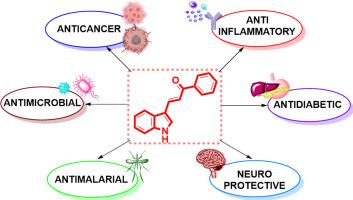吲哚-查尔酮复合物作为一种具有多种治疗潜力的有前途的支架材料综述
IF 3
3区 医学
Q2 BIOCHEMISTRY & MOLECULAR BIOLOGY
引用次数: 0
摘要
吲哚-查尔酮复合物由于其独特的双药效团结构,结合了具有生物活性的吲哚和查尔酮,已成为现代药物化学中极具发展前景的一类化合物。最近的研究强调了这些杂交体具有多种有效的药理活性,包括抗癌、抗菌、抗炎、抗糖尿病、抗病毒和神经保护作用。通过分子杂交实现吲哚环和查尔酮支架的结合,促进了协同作用机制,使这些杂交体能够调节多种生物途径,从而增强其治疗潜力。本文综述了吲哚-查尔酮杂合体的构效关系,以确定影响其生物活性的关键分子决定因素。此外,本文还讨论了这些杂交种的多功能特性,为开发出更有效、更高效、更低毒性的新型治疗剂提供了广阔的前景。通过巩固现有的研究成果,本综述旨在提供一个全面的资源来指导未来的研究工作,并促进吲哚-查尔酮复合物作为药物发现的多功能支架的继续探索。本文章由计算机程序翻译,如有差异,请以英文原文为准。

A comprehensive review on indole-chalcone hybrid as promising scaffold with diverse therapeutic potential
Indole-chalcone hybrids have emerged as a highly promising class of compounds in modern medicinal chemistry, owing to their unique dual pharmacophore structure that integrates the bioactive indole and chalcone units. Recent studies have highlighted these hybrids' diverse and potent pharmacological activities, including anticancer, antimicrobial, anti-inflammatory, antidiabetic, antiviral, and neuroprotective effects. The combination of the indole ring and chalcone scaffold, achieved through molecular hybridization, facilitates a synergistic mechanism of action, enabling these hybrids to modulate multiple biological pathways and thereby enhance their therapeutic potential. This review focuses on indole-chalcone hybrids' structure-activity relationship (SAR) to identify the key molecular determinants that contribute to their bioactivity. Furthermore, the multifunctional nature of these hybrids is discussed, offering promising prospects for developing novel, more effective therapeutic agents with optimized efficacy and reduced toxicity. By consolidating current findings, this review aims to provide a comprehensive resource to guide future research efforts and facilitate the continued exploration of indole-chalcone hybrids as versatile scaffolds in drug discovery.
求助全文
通过发布文献求助,成功后即可免费获取论文全文。
去求助
来源期刊

Bioorganic & Medicinal Chemistry
医学-生化与分子生物学
CiteScore
6.80
自引率
2.90%
发文量
413
审稿时长
17 days
期刊介绍:
Bioorganic & Medicinal Chemistry provides an international forum for the publication of full original research papers and critical reviews on molecular interactions in key biological targets such as receptors, channels, enzymes, nucleotides, lipids and saccharides.
The aim of the journal is to promote a better understanding at the molecular level of life processes, and living organisms, as well as the interaction of these with chemical agents. A special feature will be that colour illustrations will be reproduced at no charge to the author, provided that the Editor agrees that colour is essential to the information content of the illustration in question.
 求助内容:
求助内容: 应助结果提醒方式:
应助结果提醒方式:


